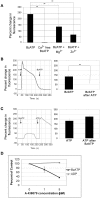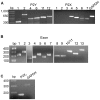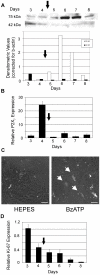Corneal epithelium expresses a variant of P2X(7) receptor in health and disease
- PMID: 22163032
- PMCID: PMC3232242
- DOI: 10.1371/journal.pone.0028541
Corneal epithelium expresses a variant of P2X(7) receptor in health and disease
Abstract
Improper wound repair of the corneal epithelium can alter refraction of light resulting in impaired vision. We have shown that ATP is released after injury, activates purinergic receptor signaling pathways and plays a major role in wound closure. In many cells or tissues, ATP activates P2X(7) receptors leading to cation fluxes and cytotoxicity. The corneal epithelium is an excellent model to study the expression of both the full-length P2X(7) form (defined as the canonical receptor) and its truncated forms. When Ca(2+) mobilization is induced by BzATP, a P2X(7) agonist, it is attenuated in the presence of extracellular Mg(2+) or Zn(2+), negligible in the absence of extracellular Ca(2+), and inhibited by the competitive P2X7 receptor inhibitor, A438079. BzATP enhanced phosphorylation of ERK. Together these responses indicate the presence of a canonical or full-length P2X(7) receptor. In addition BzATP enhanced epithelial cell migration, and transfection with siRNA to the P2X(7) receptor reduced cell migration. Furthermore, sustained activation did not induce dye uptake indicating the presence of truncated or variant forms that lack the ability to form large pores. Reverse transcription-polymerase chain reaction and Northern blot analysis revealed a P2X(7) splice variant. Western blots identified a full-length and truncated form, and the expression pattern changed as cultures progressed from monolayer to stratified. Cross-linking gels demonstrated the presence of homo- and heterotrimers. We examined epithelium from age matched diabetic and non-diabetic corneas patients and detected a 4-fold increase in P2X(7) mRNA from diabetic corneal epithelium compared to non-diabetic controls and an increased trend in expression of P2X(7)variant mRNA. Taken together, these data indicate that corneal epithelial cells express full-length and truncated forms of P2X(7), which ultimately allows P2X(7) to function as a multifaceted receptor that can mediate cell proliferation and migration or cell death.
Conflict of interest statement
Figures








Similar articles
-
Interaction of alpha1D-adrenergic and P2X(7) receptors in the rat lacrimal gland and the effect on intracellular [Ca2+] and protein secretion.Invest Ophthalmol Vis Sci. 2011 Jul 29;52(8):5720-9. doi: 10.1167/iovs.11-7358. Invest Ophthalmol Vis Sci. 2011. PMID: 21685341 Free PMC article.
-
Ca(2+) spiking activity caused by the activation of store-operated Ca(2+) channels mediates TNF-α release from microglial cells under chronic purinergic stimulation.Biochim Biophys Acta. 2013 Dec;1833(12):2573-2585. doi: 10.1016/j.bbamcr.2013.06.022. Epub 2013 Jul 2. Biochim Biophys Acta. 2013. PMID: 23830920
-
Murine epidermal Langerhans cells and keratinocytes express functional P2X7 receptors.Exp Dermatol. 2010 Aug;19(8):e151-7. doi: 10.1111/j.1600-0625.2009.01029.x. Exp Dermatol. 2010. PMID: 20113349
-
P2X receptor antagonists and their potential as therapeutics: a patent review (2010-2021).Expert Opin Ther Pat. 2022 Jul;32(7):769-790. doi: 10.1080/13543776.2022.2069010. Epub 2022 May 11. Expert Opin Ther Pat. 2022. PMID: 35443137 Review.
-
Gene delivery to cornea.Brain Res Bull. 2010 Feb 15;81(2-3):256-61. doi: 10.1016/j.brainresbull.2009.06.011. Epub 2009 Jun 26. Brain Res Bull. 2010. PMID: 19560524 Free PMC article. Review.
Cited by
-
Sustained Ca2+ mobilizations: A quantitative approach to predict their importance in cell-cell communication and wound healing.PLoS One. 2019 Apr 24;14(4):e0213422. doi: 10.1371/journal.pone.0213422. eCollection 2019. PLoS One. 2019. PMID: 31017899 Free PMC article.
-
An Essential and Synergistic Role of Purinergic Signaling in Guided Migration of Corneal Epithelial Cells in Physiological Electric Fields.Cell Physiol Biochem. 2019;52(2):198-211. doi: 10.33594/000000014. Epub 2019 Feb 28. Cell Physiol Biochem. 2019. PMID: 30816668 Free PMC article.
-
Aberrations in Cell Signaling Quantified in Diabetic Murine Globes after Injury.Cells. 2023 Dec 21;13(1):26. doi: 10.3390/cells13010026. Cells. 2023. PMID: 38201230 Free PMC article.
-
Age Dependent Changes in Corneal Epithelial Cell Signaling.Front Cell Dev Biol. 2022 May 5;10:886721. doi: 10.3389/fcell.2022.886721. eCollection 2022. Front Cell Dev Biol. 2022. PMID: 35602595 Free PMC article.
-
Epithelial wound healing in Clytia hemisphaerica provides insights into extracellular ATP signaling mechanisms and P2XR evolution.Sci Rep. 2023 Nov 1;13(1):18819. doi: 10.1038/s41598-023-45424-5. Sci Rep. 2023. PMID: 37914720 Free PMC article.
References
-
- Abbracchio MP, Burnstock G. Purinergic Signaling: Pathophysiologic Roles. Jpn J Pharmacol. 1998;78:113–145. - PubMed
-
- Ralevic V, Burnstock G. Receptors for Purines and Pyrimidines. Pharmacol Rev. 1998;50:413–492. - PubMed
-
- North RA. Molecular Physiology of P2X Receptors. Physiol Rev. 2002;82:1013–1067. - PubMed
-
- Ferrari D, Pizzirani C, Adinolfi E, Lemoli RM, Curti A, et al. The P2X7 Receptor: A key player in IL-1 processing and release. J Immunol. 2006;176:3877–3883. - PubMed
Publication types
MeSH terms
Substances
Grants and funding
LinkOut - more resources
Full Text Sources
Miscellaneous

